Stourbridge, Worcestershire
Up to 1834
A parliamentary report of 1777 recorded parish workhouses in operation at Stourbridge (for up to 40 inmates), Old Swinford (40), and Hales Owen (260). Kingswinford had a parish workhouse at a site about a mile to the south of the town on Stream Road. Cradley had a workhouse on Oldnall Road.
Halesowen was one of the workhouses to issue its own coinage in the form of workhouse tokens in the early 1800s when there was a national shortage of copper coins. The tokens could be spent locally to buy bread and other basic commodities.
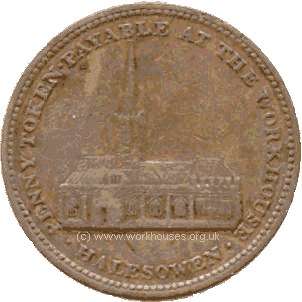
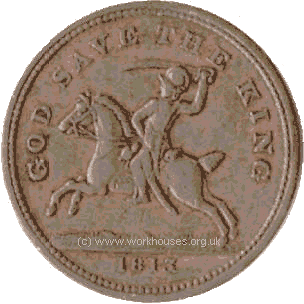
Halesowen 1813 workhouse token.
© Peter Higginbotham.
In 1835, Stourbridge had a workhouse on the High Street with Thomas Crudgington as its master, while the Old Swinford workhouse stood on Hagley Road with John Fairfield as master. At the Halesowen workhouse on Church Street, Sarah Foley was governess.
After 1834
Stourbridge Poor Law Union was formed on 13th October 1836. Its operation was overseen by an elected Board of Guardians, 24 in number, representing its 14 constituent parishes as listed below (figures in brackets indicate numbers of Guardians if more than one):
Worcestershire: Cradley, Lutlers, Old Swinford (3), Stourbridge (3).
Shropshire: Cakemore, Halesowen Borough (2), Hasbury, Hawn, The Hill, Illy, Lapal, Ridgacre.
Staffordshire: Amblecote, Kingswinford (6).
The population falling within the Union at the 1831 census had been 35,911 — ranging from Hawn (population 98) to Kingswinford (15,156) with Oldswinford the next biggest parish (6,490) then Stourbridge itself (6,145). The average annual poor-rate expenditure for the period 1834-36 had been £8,339.
Initially, the former Kingswinford parish workhouse was used by the new Stourbridge Union. The Poor Law Commissioners authorized and expenditure of £1,500 for its enlargement, the architect of which was a Mr Griffiths. Over the next half century a number of additions and alterations were made. Additional land was purchased in 1858-9, with the erection of new infectious wards in 1861 and 1871, a children's block in 1869, and a detached board-room at the west of the workhouse in around 1874.
The 1869 children's building included schools for 200 children with dormitories above, a class room, staircases, lavatories, baths, water closets, play sheds and playground. The old wall and privy to the drying grounds were rebuilt as the playground walls.
On 10 May 1872, the Board of Guardians agreed that 'the erection of a detached building for a Board Room with suitable offices for the deposit of the Books of the Union and waiting rooms for applicants attending for relief' was necessary. On 31 May 1872, the Board met with the architect Mr Smalman Smith and decided on a suitable site for the building. Plans were produced by the architect and then approved. However, due to the economic climate and inclement weather, the formal building contract was delayed until the spring of 1874. The Local Government Board stipulated that the building work be completed by April 1875. The builder was John Guest of Amblecote. The block included the Relieving Officer's room, the Board Room itself, a Waiting Room, a Clerk's Office, and a lavatory.
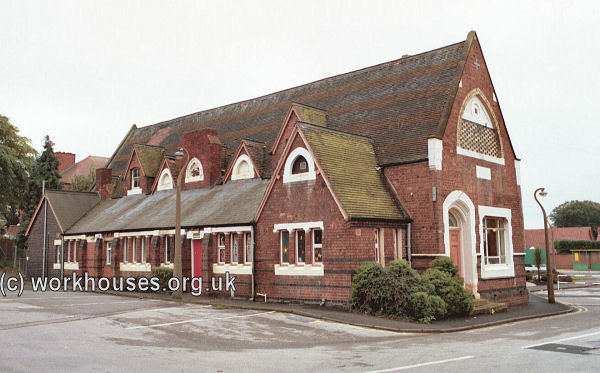
Stourbridge 1874 board-room block, 2000.
© Peter Higginbotham.
By 1900, the workhouse could accommodate 460 inmates. The location and layout of the workhouse can be seen on the 1901 map below:
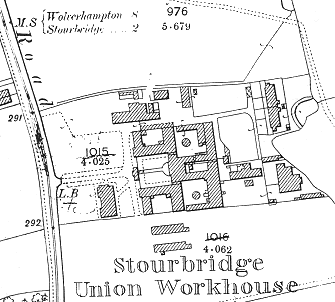
Stourbridge workhouse site, 1901.
In 1902-4, the workhouse was entirely rebuilt apart from the board-room block. The new buildings adopted a pavilion plan designed by Arthur Marshall. The new site layout can be seen on the 1919 map below:
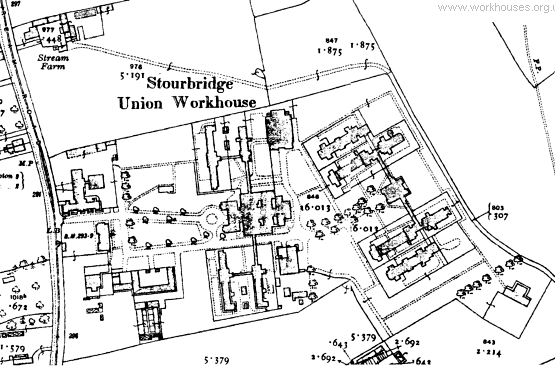
Stourbridge workhouse site, 1919.
To the north of the board-room is the casuals' block which has a foundation stone dated 2nd January 1904 laid by Chairman of the Board of Guardians, John Warr.
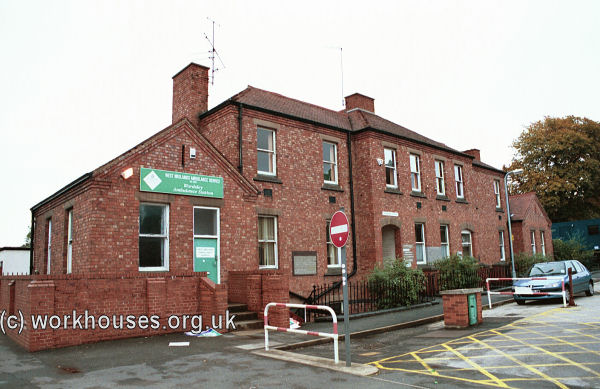
Stourbridge casuals' block, 2000.
© Peter Higginbotham.

Stourbridge new workhouse foundation stone, 2000.
© Peter Higginbotham.
At the south-west of the site is a house which, being adjacent to the work yard, may have belonged to the labour master. To the east of this are two work yards.
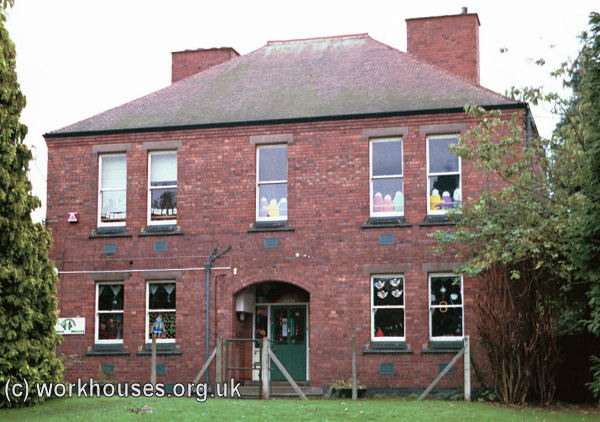
Stourbridge labour-master's house(?), 2000.
© Peter Higginbotham.
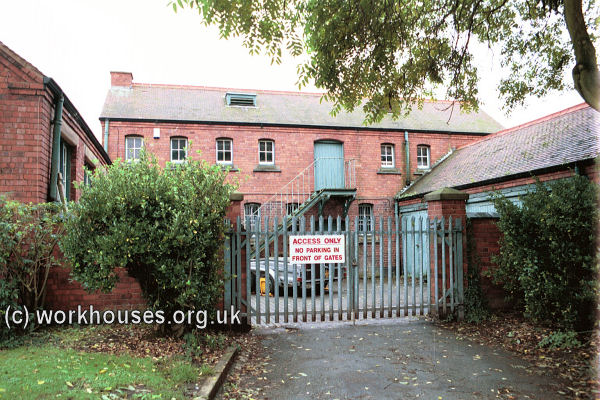
Stourbridge work yard, 2000.
© Peter Higginbotham.
The main workhouse buildings consist of a central administration block, with two accommodation pavilions on each side. The southern pavilions provided male accommodation (97 in the front block, 57 in the rear); the northern pavilions accommodated 107 women at the front, while the rear one was used as a nursery. A large pavilion-plan infirmary was erected at the east of the workhouse.
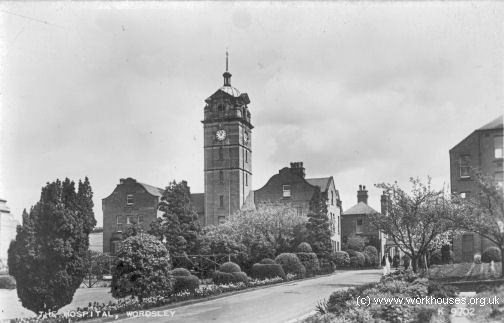
Stourbridge from the south-west, 1930s?.
© Peter Higginbotham.
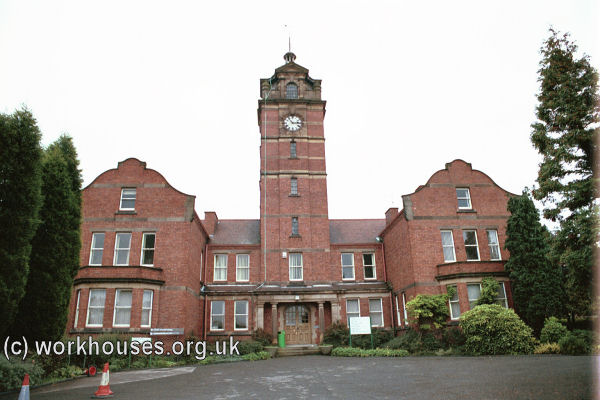
Stourbridge administration block from the west, 2000.
© Peter Higginbotham.
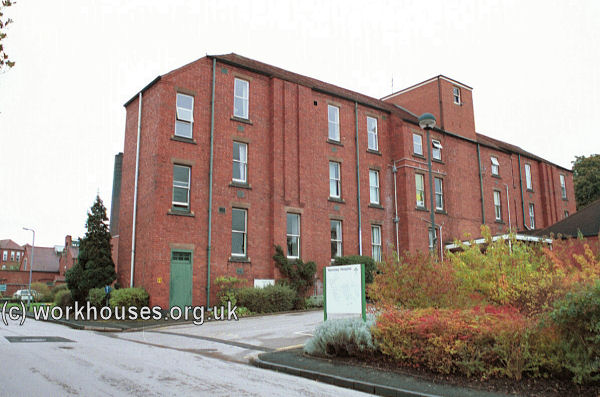
Stourbridge men's accommodation pavilion, 2000.
© Peter Higginbotham.
The boiler house to the north is adorned by the workhouse bell by which the inmates' day was ordered.
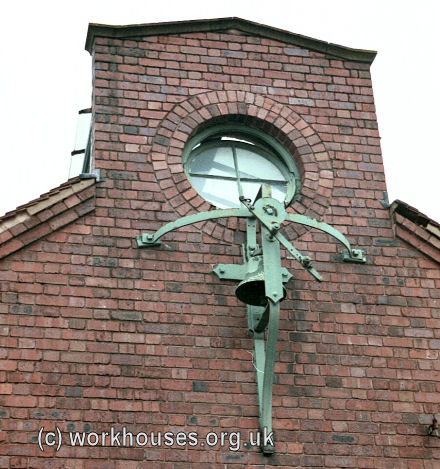
Stourbridge workhouse bell, 2000.
© Peter Higginbotham.
In 1907, inmate James Clarke died in the Stourbridge workhouse. The death was notified to his family who could, if they wished, organise the funeral themselves. If this did not happen, the Guardians arranged a burial which usually took place in a local cemetery or burial ground in an unmarked grave.
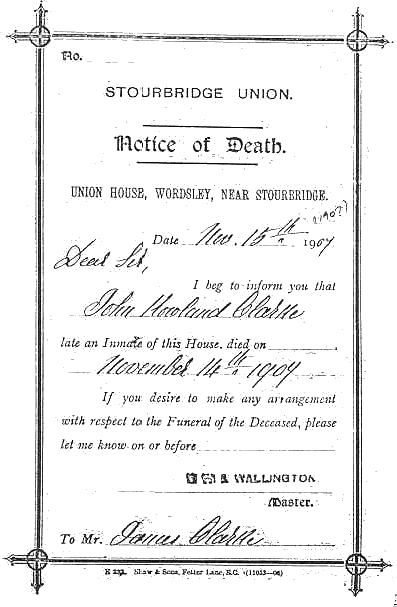
Stourbridge Death Notice, 1907.
Courtesy of Robert L Clarke.
In the summer of 1915, the workhouse infirmary was taken over to provide the 510-bed Stourbridge annexe of the 1st Southern Military Hospital which had its base at Birmingham University.
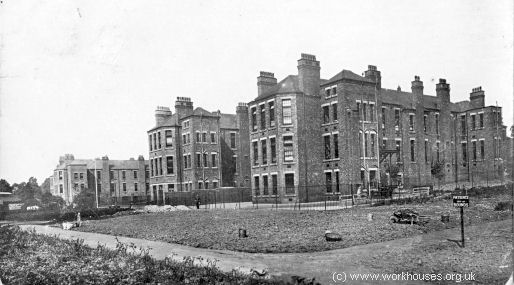
Stourbridge workhouse infirmary from the south, c.1915.
© Peter Higginbotham.
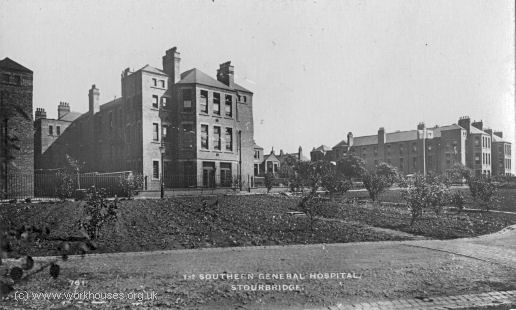
Stourbridge workhouse infirmary from the west, c.1915.
© Peter Higginbotham.
After 1930, the former workhouse became a Public Assistance Institution. Then, in 1948, the site became part of the National Health Service as Wordsley Hospital. It also later became home to the Birmingham Regional Plastic Surgery Centre.
The 1874 board-room and 1904 buildings mostly survive but the site is now (2005) closed pending redevelopment.
In 1842, the Poor Law Commissioners investigating the employment and conditions of children in mines and manufactories, discovered that workhouse boys, some as young as eight, were being sent on "apprenticeships" of up to twelve years working in coal mines. As a result, some unions in the coal-mining districts of South Staffordshire and adjacent areas were asked to provide detailed information on the children who had been apprenticed in the mining industry in recent years. Stourbridge recorded only two such cases: in 1841, Richard Morgan, aged 10, was apprenticed until the age of 21 to John Blakeway, butty collier to Messrs. Grazebrooks, Netherton Colliery, Dudley; in 1842, Cornelius Deeley, aged 14, was apprenticed until the age of 21 to Thomas Gould, butty collier at a British Iron Company mine. The Stourbridge union clerk, Henry Duignan, also assured the Commissioners that any boys so apprenticed were believed to be properly treated by their masters.
Norton Cottage Homes
In 1902-4, the Stourbridge Guardians erected children's cottage homes on an eight-acre, green-field site at Norton, to the south-west of Stourbridge. The scheme, designed by Arthur Marshall, homes comprised a superintendent's house, a workshop block, a small isolation hospital and two pairs of semi-detached houses, one for boys and one for girls, each house accommodating fifteen children. The superintendent's house, at the entrance to the site, included a committee room and provision for housing up to six probationary children. Each children's house included a dayroom on the ground floor and two dormitories above, plus accommodation for the matron. The single-storey workshops included a carpenter's shop, a boot-making shop, and a tailor's shop. The isolation hospital, at the far south of the site, had boys' and girls' wards, each housing two beds, with a nurses' room at the centre.
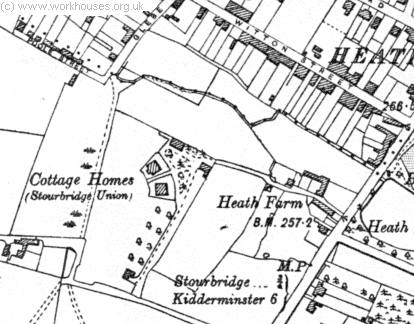
Stourbridge cottage homes site, 1921.
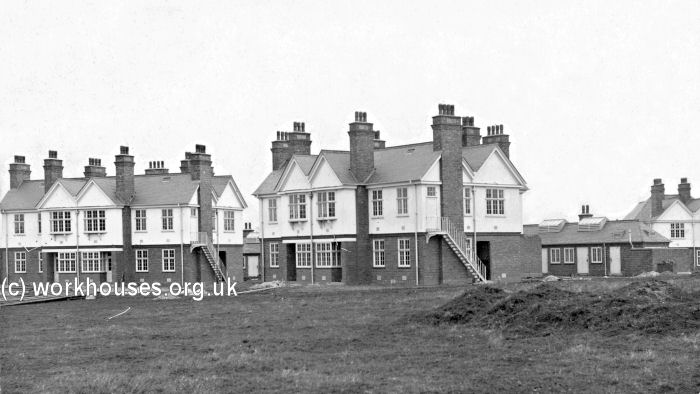
Stourbridge cottage homes from the south-west.
The homes have now been demolished and modern housing occupies the site.
Staff
Inmates
Records
Note: many repositories impose a closure period of up to 100 years for records identifying individuals. Before travelling a long distance, always check that the records you want to consult will be available.
- Staffordshire Record Office, Eastgate Street, Stafford, ST16 2LZ. Holdings include: Guardians' minute books (1836-1929); Pauper classification books (1847-1907); Letter books (1836-98); etc.
Bibliography
- Wordsley Workhouse and Wordsley Hospital by J. Godfrey, J. R. Richardson and VI Form Students of the Summerhill School, 1978.
Links
- None.
Acknowledgment
- Thanks to Michelle Higgs for information on the Stourbridge workhouse.
Unless otherwise indicated, this page () is copyright Peter Higginbotham. Contents may not be reproduced without permission.


